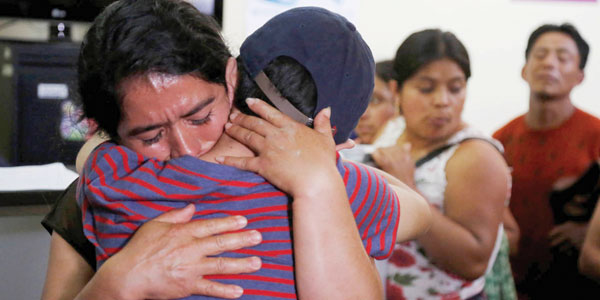
By Tere Siqueira
A newly released memo obtained by Open The Government (OTG) and the Project on Government Oversight (POGO) through the Freedom of Information Act (FOIA) shows that the secretary of the U.S. Department of Homeland Security (DHS) has been lying to the media and the public about not approving the “zero tolerance” immigration policy.
In fact, the memo shows that family separation wasn’t just a by-product of the “zero-tolerance policy” – it was the policy ordered by the administration.
Because of the immigration policy, many immigrant families have been separated – and it could be a long time before they’re reunited.
This isn’t the first time the U.S. government has implemented a separation policy. Policies like the Trump administration’s immigration policy have been applied since America became an independent nation. Examples include the following:
*Slave families: Slave owners used to split up families to pay off debts, create equal inheritance or as punishment. When the Civil War (1861-65) ended, former slaves looked for their relatives. For many, it became an impossible task because they hadn’t had contact with their relatives for years.
*Native American children: Starting in 1819, with resources provided by Congress through the Civilization Fund Act, religious organizations separated Native American children from their families to introduce them into white American society. The organizations founded boarding schools and forced the children to attend the institutions, stripping them of their language and culture.
*Mexican immigrants: During the 1930s, a massive deportation of Mexican immigrants took place. Law enforcement agents forced Mexican immigrants and Mexican-Americans to relocate to Mexico. Known as the Mexican Repatriation, there were many cases where families were separated, in which the children were U.S. citizens, but the parents weren’t.
*Japanese internment camps: After the attack on Pearl Harbor in 1941, an executive order gave the military the authority to exclude Japanese-Americans living on the West Coast. Moreover, 120,000 Japanese-Americans had to live in internment camps, surrounded by barbed wire and armed guards. Some people have compared the treatment of Japanese-Americans during World War II to the current treatment of Hispanic immigrants.
Otras veces en el pasado en las que el gobierno de EE. UU. ha separado a las familias de las minorías
Un memorandum recién publicado que fue obtenido por Open The Government (OTG) y Project on Government Oversight (POGO) a través de la Ley de Libertad de Información (FOIA) muestra que la secretaria del Departamento de Seguridad Nacional (DHS) ha estado mintiendo a los medios y el público acerca de no aprobar la política de inmigración de cero tolerancia “.
De hecho, el memorándum muestra que la separación familiar no fue sólo un subproducto de la “política de cero tolerancia “: fue la política ordenada por el gobierno. Como resultado, muchas familias inmigrantes se han separado y podría pasar mucho tiempo antes de que se reúnan.
Pero esta no es la primera vez que el gobierno de EE. UU. implementa una política de separación. Políticas como la de inmigración del gobierno de Trump se han aplicado desde que Estados Unidos se convirtió en una nación independiente. Los ejemplos incluyen lo siguiente:
* Familias esclavas: Los propietarios de esclavos solían dividir familias para pagar deudas, crear una herencia equitativa o como castigo. Cuando terminó la Guerra Civil (1861-65), los que fueron esclavos comenzaron a buscar a sus parientes. Para muchos, se convirtió en una tarea imposible porque no habían tenido contacto con sus familiares durante años.
* Niños nativos americanos: A partir del 1819, con recursos proporcionados por el Congreso a través de la Civilization Fund Act, las organizaciones religiosas separaron a los niños nativos de sus familias para introducirlos en la sociedad estadounidense blanca. Las organizaciones fundaron internados y obligaron a los niños a asistir a las instituciones, despojándoles de su idioma y cultura.
* Inmigrantes mexicanos: Durante la década de 1930, tuvo lugar una deportación masiva de inmigrantes mexicanos. Los agentes del orden obligaron a los inmigrantes mexicanos y mexicano-americanos a mudarse a México. Conocida como la repatriación mexicana, hubo muchos casos en los que las familias fueron separadas, en las cuales los niños eran ciudadanos de los EE. UU., pero los padres no.
* Campamentos de concentración japoneses: Después del ataque a Pearl Harbor en 1941, una orden ejecutiva otorgó a los militares la autoridad de excluir a los estadounidenses de origen japonés que vivían en la costa oeste. Además, 120,000 japoneses-estadounidenses tuvieron que vivir en campos de concentración, rodeados de alambre de púas y guardias armados. Algunas personas han comparado el trato que recibieron los japoneses-estadounidenses durante la Segunda Guerra Mundial con el trato actual de los inmigrantes hispanos.










